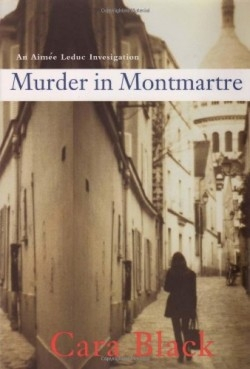Murder in Montmartre
An Aimee Leduc Investigation
There were always ghosts, she thought, and they were even more poignant at this time of year: souls, wandering at night over the cobblestones, flitting through the dark paved courtyards, leaving exhalations of the past behind them.
In an opening as haunting as the city she describes, the author introduces the reader to Paris, where the ghosts of its past are as much a central character to the story as the inventive, insouciant Aimée Leduc. Aimée of Leduc Detective, has her ghosts too, haunted as she is by the unexplained death of her father, a former policeman turned private detective, who was killed in an explosion six years earlier.
Seeking to find the truth behind the murder of policeman Jacques Gagnard, on the roof of a Montmartre apartment building, and to clear her childhood friend and policewoman, Laure Rousseau, of the killing, Aimée risks her life following clues up and down the streets and many steps of Montmartre. Though it starts as a simple murder investigation, it quickly turns into a morass of undercover work to catch a group of Corsican terrorists, and a search for the truth behind her father’s death.
What makes this mystery as delectable as a richly-layered French pastry is the well-developed and original characters, such as Aimée’s partner, René, a dwarf who is also a computer wizard hoping to become a private detective; Aimée’s godfather, Commissaire Morbier, with his basset-hound-like eyes that hide secrets of the past; and the mysterious dark, curly-haired man, Lucien, a suspect who plays music on his mandolin-like instrument, the cetera, that recalls the sunshine and good life of Corsica.
The author has published several previous mystery novels set in different neighborhoods in Paris, including Murder in the Bastille and Murder in the Marais, and she makes annual trips from her home in San Francisco to Paris to do research. Black manages to make even her secondary characters three-dimensional originals with their own personal quirks and places in European history. Zoe Tardu, for example, a witness to Gagnard’s murder, is the agoraphobic daughter of the Nazi program to propagate Aryans, as well as stepdaughter to a surrealist.
As Aimée investigates the murder, she discovers how history is shaping the present, and comes to a clearer understanding about her father’s death. So, though the past still greets her from every corner of Paris, “at this moment, in the lingering shadows of dusk, with the whine of sirens in the distance, a child’s laughter from a passing stroller, and the Seine lapping below her, she felt at ease with the ghosts. For now.”
For the reader, the memory of Black’s seductive descriptions of the City of Light, her unique characters, and her expert layering of past and present will be as haunting as Paris itself.
Disclosure: This article is not an endorsement, but a review. The publisher of this book provided free copies of the book to have their book reviewed by a professional reviewer. No fee was paid by the publisher for this review. Foreword Reviews only recommends books that we love. Foreword Magazine, Inc. is disclosing this in accordance with the Federal Trade Commission’s 16 CFR, Part 255.

